Paver Driveway Installation Company
Serving clients in the Minneapolis, St. Paul, Edina, Plymouth, Minnetonka & Blaine areas
Paver Driveway Design & Installation Contractor
High End Driveways that Won't Crack
You would be mistaken to underestimate the power of a gorgeous driveway. It is true that a driveway is meant to be functional, providing a gateway to home.
However, it is also the first thing visitors will notice as they stand outside your home. Even if your land is beautifully manicured and the paint on your house is fresh, it will all be for naught if your driveway is not up to snuff.
The driveway design that you choose will have an intense effect on the way other people view your home from the outside. Friends, family neighbors and all other visitors will have their attention drawn to your driveway ahead of all else. In addition, a magnificent driveway will have desirable curb appeal and increase the value of your home as well.
Driveway Materials to Suit Your Modern Style
The first thing you need to consider is the width and design of the driveway. No two driveways are alike. If your driveway is long and narrow, you may get the most aesthetic results using asphalt. If the driveway is long and winding, it would look best in stone pavement. You must consider the many different types of available driveway materials in addition to the type of edging you desire.

Keep in mind as you are searching through various styles and pricing materials, in most cases, driveway construction is not a do-it-yourself kind of job. It takes time, planning and experience. Typical paver driveway installations take anywhere from 3 days with a full crew of trained workers to over a week. It depends on the intricacy of the design and the type of soil. Asphalt and concrete installations can take a similar amount of time.
Take the time to step back from it all and really look at your home and yard as a whole. Think about the type of driveway that will best complement you own style. Consider the landscaping features that you already have in place. For example, a stone water fountain would really stand out alongside a beautiful stone driveway. Perhaps you have a granite flowerbed that would look best with loose stone or granite in the driveway. The color of the driveway needs to match.
A wide variety of driveway materials are available. It is important that you choose the one that will best enhance the entryway to your home. You may want to consult an expert to determine if asphalt, brick, concrete, granite, loose stone or natural stone will best compliment your home and yard. For Minnesota driveways, the best choice is paver stones. They allow for expansion and contraction due to the extreme temperatures and wont crack like concrete. If you would like to learn more about concrete vs. paver driveways, read more about it at our blog post.
Your Ideal Driveway Design
Several features of your property will help you determine the driveway options that will best suit you. A few things to consider include the location of the entry to the driveway and the layout of the arrival destination, such as a garage or parking area. Learn more about Driveway Design
You would also want to consider the water absorption of the ground underneath the paver stones. If your ground does not absorb water very quickly, some outdoor drainage solutions would need to be put in place to prevent water buildup. Those solutions might include putting a deeper base of rock or some drainage tubing to collect the water.

A short driveway will need to be a direct route, while a longer driveway will provide you with more options. A longer driveway also offers more room for visitors and family members. As mentioned earlier, you also need to make sure surface water is directed off your driveway correctly. A properly designed and installed paver driveway will direct the water to the right areas and stay in place for many years to come.
Types of Paver Driveways
- Basic – A basic driveway leads straight from the entry road to a side garage or driveway apron.
- Circular – A circular driveway design will generally begin at the road, across the area near the front door and back out onto the street, basically in a loop.
- Courtyard – A courtyard driveway design may resemble old European estates or may be more contemporary. The central area, which can be circular or square, is usually paved.
The Best Paver Driveway Design & Installation
KG Landscape Management has the experience and knowledge to help you plan and install the perfect entryway to your home.
Driveway Drainage Solutions
Many homes have driveways that slope toward the garage or home. During rainstorms, water can flow onto your property from several sources including roofs, hillsides, and your neighbor’s yard. Since concrete and asphalt are impermeable, when water reaches your driveway it is no longer absorbed into the ground and often flows into your garage, or worse, your home. We get so many calls about driveway drainage issues, we thought we would lay out some of the main ways that we solve this problem. We often need to consider downspout drainage solutions when designing drainage plan for driveways as well

The Wrong Driveway Drainage Solution
Many homeowners believe they can solve their driveway drainage problems by simply moving dirt (grading) or digging shallow trenches. These temporary fixes do not effectively solve the problem and can actually make the problem worse. The majority of homeowners report that they are unhappy with the results of temporary solutions—and end up trying another approach within 12 months.
The Right Driveway Drainage Solutions
Driveway Drains
For some properties, especially those that sit below street level, it’s difficult to solve the drainage problem with correct placement and slope alone. In this situation, driveway drains will need to be installed. A trench drain can be installed where the driveway meets the garage. This type of drain is long and narrow and should run the entire width of the driveway. A trench drain must be covered by a grate to keep it free of debris that could clog the pipe. Decorative grates are available for trench drains that can be used as a unique design element. Smaller site drains can also be used in specific areas of the driveway where water collects.

Drainage Pipes
On extremely long driveways, consider having a gulley or drainage pipes at the sides of the drive for the runoff of moisture. These will carry the water away and deposit it in another place. However, it’s important to consider where it will be carried. Unless the ground is damp or marshy, creating drainage from crushed rock and pebbles, with a porous or drilled pipe above, will allow the water to drain into the ground. This is a better option than carrying it away to a storm drain. You can also use this system to direct the water away toward an area of your property that might be able to handle it, such as a woods or pond.

Swales
Land on either side of the driveway may be pitched toward the driveway, sending too much water to the driveway area. One solution to this situation is to grade the land at the driveway edge away from the driveway. This will then meet the land sloping toward the driveway so that a drainage swale can be created. A drainage swale is a pitched channel, typically located in lawn and not very noticeable, which takes water away to a lower location.

Whatever solution you decide is best for your situation, the main goal is to ensure that water is carried away from your garage and home to an area that can properly handle the excess water. Though it is entirely possible to implement any of the solutions mentioned above yourself, it is often the best option to consult an expert who deals with situations like yours on a daily basis and has many years of experience. The benefits to paying a contractor are there will be a guarantee behind any work performed, a solution tailored to your specific problem, and experience usually means fast and high-quality work.
Learn How KG Landscape Can Help Design & Build
Your New Patio Space
Give us a call today!
